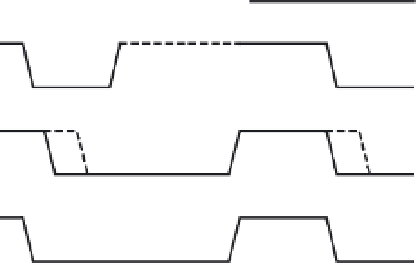Hardware Reference
In-Depth Information
Start counting
high period
Wait
state
CLK1
Counter
reset
CLK2
SCL
Figure 11.8
■
Clock synchronization during the
arbitration procedure
When all devices concerned have counted off their low period, the clock line will be released
and go high. There will then be no difference between the device clocks and the state of the
SCL line, and all the devices will start counting their high periods. In this way, a synchronized
SCL clock is generated with its low period determined by the device with the longest clock low
period and its high period determined by the one with the shortest clock high period.
Clock synchronization occurs when multiple masters attempt to drive the I
2
C bus and be-
fore the arbitration scheme can decide which master is the winner. The I
2
C bus arbitration
process will be discussed in the next section.
H
ANDSHAKING
The clock synchronization mechanism can be used as a handshake in data transfer. Slave de-
vices may hold the SCL low after completion of a 1-byte transfer (9 bits). In such a case, the slave
halts the bus clock low and forces the master clock into wait states until it releases the SCL line.
C
LOCK
S
TRETCHING
The clock synchronization mechanism can be used by slaves to slow down the bit rate of
a transfer. After the master has driven SCL low, the slave can drive SCL low for the required
period and then release it. If the slave SCL low period is greater than the master SCL low period,
then the resulting SCL bus signal low period is stretched.
I
2
C allows multiple master devices to coexist in the system. In the event that two or more
master devices attempt to begin a transfer at the same time, an arbitration scheme is employed
to force one or more masters to give up the bus. The master devices continue transmitting until
one attempts a high while the other transmits a low. Since the bus driver has open drain, the bus
will be pulled low. The master attempting to transfer a high signal will detect a low on the SDA
line and give up the bus by switching off its data output stage. The winning master continues its
transmission without interruption; the losing master becomes a slave and receives the rest of the
transfer. This arbitration scheme is nondestructive: One device always wins, and no data is lost.
An example of the arbitration procedure is shown in Figure 11.9, where Data1 and Data2 are
data driven by device 1 and device 2 and SDA is the resultant data on the SDA line. The moment
there is a difference between the internal data level of the master generating Data1 and the ac-
tual level on the SDA line, its data output is switched off; this means that a high output level is
then connected to the bus. This will not affect the data transfer initiated by the winning master.






Search WWH ::

Custom Search